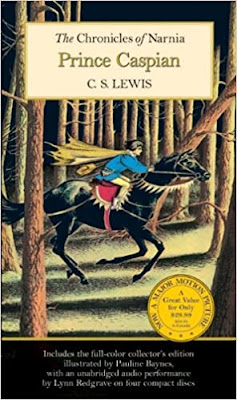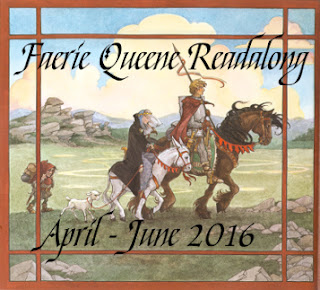Narniathon: Prince Caspian
The second installment of the Narnia chronicles was published in 1951, just a year after LWW. I heard after last month's post that Lewis had all seven stories finished by the time LWW was published, and now I'm not sure on that point. Anyone?
It is a year after the Pevensie children's Narnia adventure, and they are in a depressing state: they're waiting at a train station to go back to their boarding schools (Lucy for the first time). I'm guessing that this makes Lucy about ten and Peter about sixteen, maybe a year younger. They're magically dragged into a different world, and it takes them a while to realize that this is Narnia -- but Narnia changed by many centuries of time. You undoubtedly know the story, so I don't need to rehearse it, but I'll just throw in a few observations.
As before, Lucy is the innocent one with the most faith. (Her name means light, after all.) Lucy has to learn courage, and to do what she knows is right even though everyone disagrees or is even angry at her. Edmund takes her side though, remembering that she has been right before and wanting to make up for his old mistake. Peter feels the burden of being the High King; he's responsible for everyone and has to make the final decisions for the group, and eventually take the lead in planning strategy. He tries to judge well, though he's not always right, and it becomes his job to risk his life and fight King Miraz.
Susan doesn't get as much play in this story. She's very grumpy and resistant to Lucy's insistence that Aslan is there and wants them to go a different direction, and so she doesn't see Aslan until she is willing to change. But she is also described as very athletic -- a good swimmer and archer -- and extremely soft-hearted, so that she hates to see anything suffer. I think people tend to assume that Lewis is setting her up to fail later on, and I disagree. I'll talk about that more when we get to The Last Battle, but I think it's important to remember that Lewis wrote her as a version of his own teenage/young self. She's not supposed to be irredeemable or a failure, she's just young.
I'm very fond of Trumpkin the Dwarf, who is a cheerful skeptic. He never believes anything until it's proven to him. Sometimes I think he takes it pretty far, claiming that he doesn't believe in magic even after he realizes that the four children really are the legendary kings and queens from the old days -- how did they show up, if not by magic? But once he is convinced, he is loyal and steadfast, even when all seems hopeless, whereas Nikibrik is portrayed as mostly interested in his own welfare, not others'.
And of course, who couldn't love Reepicheep, the dashing, valiant, overly touchy Mouse leader?
I have always especially liked the part of the story that takes place at Aslan's How. The Stone Table from LWW has been covered over with a hill that contains a labyrinth of tunnels leading to the broken Table. Edmund observes, "Look at those carvings on the walls. Don't they look old? And yet we're older than that. When we were last here, they hadn't been made." It always makes me wonder just how long it's really supposed to have been since the old days of Narnia.
The planetary influence for Prince Caspian is supposed to be Mars. Again, this is never named outright; in fact, for a book that is at least half about war, it's surprisingly short on the word 'martial,' which appears only twice, once for Reepicheep. 'Marshal' appears a good deal more, because they need marshals as officers, but apparently 'marshal' has a different origin altogether! Anyway, strife and battle are indeed one of the major themes of the book. The children quickly become more like what they were in their former Narnian life, and most of it is that they are tougher and more warlike. The boys are brave and even "very dangerous" knights. Iron is Mars' metal, and there is a lot about steel armor and clashing weapons.
The other facet of Mars' personality that gets a lot of play is about forests and greenery. Cato always said Mars Silvanus -- of the forest -- and it seems that the lesser god Silvanus must have been associated with, or an aspect of, Mars. He was the god of untamed growth, the parts of the world that weren't cultivated. In Prince Caspian, true Narnians love the forests, and anything untamed, while the Telmarines hate and fear them. Trees and their attending spirits are everywhere, and we see other deities associated with Silvanus: Pomona (who Silvanus loves) right at the start, and Bacchus/Pan and Silenus at the great feast. At their arrival in the town, ivy grows wildly everywhere (Spenser describes Silvanus as wearing an ivy belt), and the bridge and other signs of civilization are torn down.
See you next month for The Voyage of the Dawn Treader!






Did you get the idea of Mars from the planet Narnia theory? I'm reading Lewis' collection of letters so when I get to where he's writing these books, I'll be looking hard for any illumination. Your comments about Susan and Trumpkin are spot on, I think. I'm just finishing this book off but can't wait until the next one!
ReplyDeleteYes, I've read Planet Narnia twice, though not recently, and I find it convincing. I am a secret medieval cosmology fan, and The Discarded Image is one of my favorite Lewis books, so I thought I'd do a little bit on that for each book.
DeleteThe books weren't all written by the time LWW was published, though the first three were. There's information about chronology on the Wikipedia page: https://en.wikipedia.org/wiki/The_Chronicles_of_Narnia (under "Books")
ReplyDeleteI agree about Susan. I don't think she is ever targeted as evil or unredeemable, even in The Last Battle. I'll be talking more about that when that book rolls around.
I love Trumpkin too, and the Aslan's How scene as well. The idea of being back to a place where you once were but has changed almost out of recognition is intriguing; more could have been made of this, but it's still an evocative element of the story.
Yes, I wished for more too. I suppose Lewis wanted to keep that in the background; it makes for atmosphere, but isn't fully developed...sigh.
DeleteExcellent and most interesting points, Jean, and I can't say I really disagree with any of them! I'll reply to your comments in a little more detail in my Narniathon post but for now I'll just mention the Stone Table and Aslan's How because of Lewis's possible inspirations for them.
ReplyDeleteThe Stone Table is modelled on Neolithic cromlechs and dolmens that Lewis will have been familiar with in his native Northern Ireland (he was born there when Ireland was still ruled by the British) and possibly in the Cotswold Hills around Oxford. Often called Druidic altar stones such structures were the remains of chambers within earthern barrows where ancient Britons would have buried their dead, the mounds covering them having been eroded away over the millennia.
As for Aslan's How (the last word from Anglo-Saxon 'hlaw' meaning burial mound or tump) Lewis may well have been thinking of New Grange in Ireland, a massive monument (restored in recent years) with passages and burial chambers and upright orthostats and stone lintels covered in mysterious carvings. For us mounds have been reduced to 'tables', but in Narnia time works in mysterious ways... I'll probably do a post about this later this month!
DeleteChris
I learned after I published the post (I'm trying to write the posts first and read/listen to everybody else after) that the 'How' is the same as Hoo in Sutton Hoo. I've been to West Kennet Long Barrow, so I was imagining a bigger version of that -- boy I'd love to see New Grange. I love neolithic monuments; it's probably a side effect of living in California, where almost everything is new except sometimes grinding holes in stones.
DeleteGosh, I'm behind now, but reading this post makes me want to do a full reread of the series. I got a fancy Folio Society box set of the Chronicles of Narnia last year (last year??? or the year before? WHAT IS TIME) so it would be a good moment for it. I haven't read Prince Caspian -- it isn't one of my favorites -- for years.
ReplyDeleteJoin, Jenny, join!
DeleteDo it, Jenny! Join us. I know PC isn't considered a shining star of the Narnia chronicles, but it has its points! (For one thing, I can't think of the word 'abominable' without remembering Peter spelling it with an H for extra majesty.)
DeleteSuch a wonderful capture of the myths and legends of Narnia. I am enjoying all the various points of view on these books by those participating in this readalong.👍
ReplyDelete